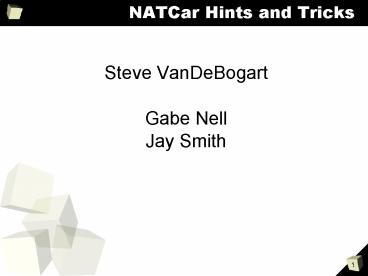NATCar Hints and Tricks PowerPoint PPT Presentation
1 / 14
Title: NATCar Hints and Tricks
1
NATCar Hints and Tricks
- Steve VanDeBogart
- Gabe Nell
- Jay Smith
2
Physical Construction
- Sturdy
- Two foot drop test
- Bumper to protect front wheels
- Ruler on the bumper
- Metal (bolts) conduct!
- Nuts and bolts will loosen
- Lock-Tight ?
- Make it easy to fix things
- Use plugs to connect wires
- Make sure they only go on one way
- Avoid a bendy sensor platform
3
Motor Driver
- Use big wires for this circuit
- A full H-Bridge is not necessary
- We used one transistor with regenerative braking
- Drive the transistor all the way
- We used a Max 621 to accomplish this
- (Internal charge pump 5V -gt 16V )
- Pulldown resistors
- Cutoff switch
4
Power Supply
- We used the Linear Technologies 1370 DC-DC
converter - 500 kHz, 6A switching regulator
- For low noise performance
- Use a PCB with a ground plane
- Follow layout guidelines
- Used low drop out regulators for each component
(CPU, Sensors, etc) - Leave room for noise absorbing capacitors
5
Speed Sensors
- We mounted a rubber disk on the rear axle
- Every 1/8th of the disk was removed
- An optical sensor triggered an interrupt on each
transition - Use time since last interrupt, desired velocity,
and PI control with a leaky bucket Integrator
6
Position Sensors
- We used four magnetic sensors
- Left, Right, Center (Horizontal Orientation)
- Wide (Vertical Orientation)
- Centimeter accurate detection out to 20cm in each
direction - Gain Bandwidth product is important
- PCB construction may reduce noise
7
Sensor Readings
8
Perceived Location
9
Sensor Tips
- Make it easy to generate the previous two graphs
- The ruler on the front bumper helps
- Have enough sensors so that you can
un-ambiguously know where you are relative to the
track - Keep in mind how far from the track is legal
- If you have enough CPU, convert your readings to
common units (cm, in, etc) - Generate graphs often
- We had several sensors (coils) go 'bad'
- Had to repeat work
10
More Sensor Tips
- Don't hardcode specific sensor values
- Do calibration phase
- Determine needed values during calibration
- Sensor Height can be an important variable
- Don't neglect to play with it.
11
Steering Control
- PD Steering control
- Proportional gain 5.14 radians/meter
- Derivative gain 0.514 radians/meter
- Make sure you have the right sign on your
derivative gain - New_PWM Center_PWM Max_PWM_Offset Pgain
error Dgain (error-old_error) - old_error is a circular buffer with a 10ms delay
12
Software
- Soft real time application
- Set servo value every 10ms (cheat from 20ms)
- Read sensors (takes time)
- Calculate new steering angle (may be complicated)
- Be aware of when you need to change a value for
it to take effect - Speed Control
- We did asynchronous
- Synchronous can work
- Want fine granularity on servo control
- What to do on reset?
- Development -- Stop dead
- Production -- Maybe go as best you can
13
User Interface
- You're the user, make it easy for yourself
- Label your LEDs, so you know what they mean when
you're under time pressure - Label your switches
- Have hardware controls for the settings you want
to tweak - There's not time to reload or recompile software
when it's your turn at the competition.
14
- The End

